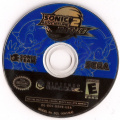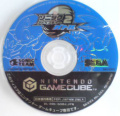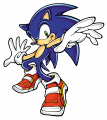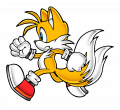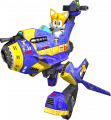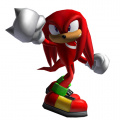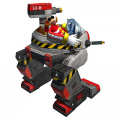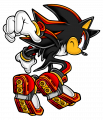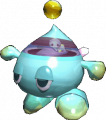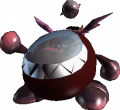Difference between revisions of "Sonic Adventure 2: Battle"
From Sonic Retro
(→Gameplay) |
|||
| Line 15: | Line 15: | ||
*The Hero and Dark sides now have separate lives, meaning that losing a life on the Hero side will not effect the lives on the Dark side and vise versa. | *The Hero and Dark sides now have separate lives, meaning that losing a life on the Hero side will not effect the lives on the Dark side and vise versa. | ||
*During Knuckles and Rouge's stages, a red exclamation point will appear when a player is right on top of an emerald/key. | *During Knuckles and Rouge's stages, a red exclamation point will appear when a player is right on top of an emerald/key. | ||
| − | *Some sound effects | + | *Some sound effects were added during gameplay, such as the sound that is made just before the GUN Hornets fire their bombs. |
| − | *Since the game | + | *Since the game is run by a faster processor than its predecessor, the game does not slow down during hectic situations. |
| − | *Some stages were also slightly modified either gameplay wise or graphically. Some gameplay changes can make a level easier or harder. In the [[Cosmic Wall]] stage, | + | *Some stages were also slightly modified either gameplay wise or graphically. Some gameplay changes can make a level easier or harder. In the [[Cosmic Wall]] stage, the A rank scores were raised significantly in the GameCube version (1st mission 53,000 -> 80,000; 4th mission 45,000 -> 75,000; last mission 50,000 -> 100,000). The [[Crazy Gadget]] stage received the most infamous graphic change. The green "X"'s on the small boxes where changed to red "X"s most likely because it looked too similar to the logo of [[Nintendo]]'s rival system, [[Xbox]]. |
| + | *Tails' and Eggman's lock-on laser is now able to mark targets at a faster rate (once every 8 frames on GameCube, whereas it takes 12 frames to mark each target in Dreamcast). Their Volkan Cannon is also able to achieve a faster rate of fire by a similar margin. | ||
| + | *The first frame of Knuckles' Spiral Upper attack, and Rouge's Screw Kick, has roughly double the reach on Dreamcast. This was removed in the remake, leaving it with only the same reach as the rest of the move. Additionally, a few more objects were given immunity to those moves, most notably the safes around the perimeter of [[Security Hall]]. | ||
*Kart Racing was given more features. By completing all of the characters' missions, a secret kart could be unlocked for each one with more advanced stats. Sonic's secret kart is actually the same kart that was available on the downloadable [[High-Speed Trial Kart Racing]] from the Dreamcast. The Eggrobo that was also downloadable on the Dreamcast could be unlocked after completing all of Rouge's missions. Chao also becomes a selectable racer in this game after completing Tails' missions. | *Kart Racing was given more features. By completing all of the characters' missions, a secret kart could be unlocked for each one with more advanced stats. Sonic's secret kart is actually the same kart that was available on the downloadable [[High-Speed Trial Kart Racing]] from the Dreamcast. The Eggrobo that was also downloadable on the Dreamcast could be unlocked after completing all of Rouge's missions. Chao also becomes a selectable racer in this game after completing Tails' missions. | ||
| Line 31: | Line 33: | ||
===Cut scene changes=== | ===Cut scene changes=== | ||
| − | *Cut scenes | + | *Cut scenes load much faster than their Dreamcast counterparts. |
*Some details for non-playable characters, such as Amy's teeth and Maria's eyelashes, were removed in the remake for some reason. | *Some details for non-playable characters, such as Amy's teeth and Maria's eyelashes, were removed in the remake for some reason. | ||
*In the scene before Knuckles enters the [[Death Chamber]], the Eggman signs from [[Pyramid Cave]] that were visible in the background were removed. Furthermore, the camera angle on Sonic during the last moments of the scene completely changed. | *In the scene before Knuckles enters the [[Death Chamber]], the Eggman signs from [[Pyramid Cave]] that were visible in the background were removed. Furthermore, the camera angle on Sonic during the last moments of the scene completely changed. | ||
| Line 56: | Line 58: | ||
*The menu themes of the playable that needed to be downloaded via the internet are available by default. This also includes the Shadow theme that was never released in America. The Omochao, Amy, and Maria theme can be bought at the Black Market in Chao World after collecting a certain amount of emblems. | *The menu themes of the playable that needed to be downloaded via the internet are available by default. This also includes the Shadow theme that was never released in America. The Omochao, Amy, and Maria theme can be bought at the Black Market in Chao World after collecting a certain amount of emblems. | ||
*The [[Sound Test]] was moved from the Options menu to the Extras menu. | *The [[Sound Test]] was moved from the Options menu to the Extras menu. | ||
| − | *Big's stage cameos were | + | *Big's stage cameos were removed, and in some cases replaced with rings. Though, Big will make cameos in the cut scenes if the {{A}} button is pressed rapidly. |
==Manuals== | ==Manuals== | ||
Revision as of 16:30, 11 December 2009
| Expression error: Unexpected < operator. |
| Sonic Adventure 2: Battle |
|---|
| System(s): Nintendo GameCube |
| Publisher: Sega |
| Developer: Sonic Team |
| Genre: 3D Platform |
</div>
Sonic Adventure 2: Battle is an upgraded port of the Sega Dreamcast's Sonic Adventure 2 for the Nintendo GameCube. It was the first Sonic game to be released on a Nintendo console. Ironically, this version of the game did not get as good reviews as its Dreamcast predecessor.
Changes from Dreamcast
Multi player
The 2P versus mode is considered the biggest change between the Dreamcast and the remake. It is most likely the inspiration of the term "Battle" that is added to the title.
- The 2P menu was completely redesigned with a different background tune. The players no longer have to choose a group making it possible for characters to face off against characters in their own alignment. Example: Sonic can now fight against Amy Rose.
- All characters that needed to be unlocked with an A rank with specific characters are now available from the start. Moreover, they were each given special stats that made each of them unique instead of just being clones of the main characters. For example, Chaos who had the same speed as Rouge in the original now has become much slower. Each character also receive their own unique special attacks. Metal Sonic's attacks were completely removed and replaced with the ability to activate the Black Shield which defends against special attacks.
- The playing system was altered so that players are no longer required to play 3 stages in a row.
- More stages were made playable, such as City Escape and Dry Lagoon. Dry Lagoon was also redesigned in 2 player mode to take place at night. Also, special races were added such as the grind race and the shooting races.
- An option menu was added. In it, the player can set a handicap, remove or enable a time limit, or set the traditional rules of VS mode from the Dreamcast.
- A new character was added, Dark Chao and its walker, in the place of Big the Cat.
- The secret character skins where also changed both in appearance and how they are obtained.
Gameplay
- The Hero and Dark sides now have separate lives, meaning that losing a life on the Hero side will not effect the lives on the Dark side and vise versa.
- During Knuckles and Rouge's stages, a red exclamation point will appear when a player is right on top of an emerald/key.
- Some sound effects were added during gameplay, such as the sound that is made just before the GUN Hornets fire their bombs.
- Since the game is run by a faster processor than its predecessor, the game does not slow down during hectic situations.
- Some stages were also slightly modified either gameplay wise or graphically. Some gameplay changes can make a level easier or harder. In the Cosmic Wall stage, the A rank scores were raised significantly in the GameCube version (1st mission 53,000 -> 80,000; 4th mission 45,000 -> 75,000; last mission 50,000 -> 100,000). The Crazy Gadget stage received the most infamous graphic change. The green "X"'s on the small boxes where changed to red "X"s most likely because it looked too similar to the logo of Nintendo's rival system, Xbox.
- Tails' and Eggman's lock-on laser is now able to mark targets at a faster rate (once every 8 frames on GameCube, whereas it takes 12 frames to mark each target in Dreamcast). Their Volkan Cannon is also able to achieve a faster rate of fire by a similar margin.
- The first frame of Knuckles' Spiral Upper attack, and Rouge's Screw Kick, has roughly double the reach on Dreamcast. This was removed in the remake, leaving it with only the same reach as the rest of the move. Additionally, a few more objects were given immunity to those moves, most notably the safes around the perimeter of Security Hall.
- Kart Racing was given more features. By completing all of the characters' missions, a secret kart could be unlocked for each one with more advanced stats. Sonic's secret kart is actually the same kart that was available on the downloadable High-Speed Trial Kart Racing from the Dreamcast. The Eggrobo that was also downloadable on the Dreamcast could be unlocked after completing all of Rouge's missions. Chao also becomes a selectable racer in this game after completing Tails' missions.
Graphics
- The main characters received slight modifications and better shading. Their shadows also became more detailed.
- Camera angles are changed or improved.
- A special background was added when a character would use a special attack.
- Objects that were transparent, such as the balloons and the Artificial Chaos, were made solid.
- Many light effects such as the flashing red lights in Iron Gate and the flashing green lights in Egg Quarters were removed or made simpler.
- Much of the text on Tails and Eggman's walkers are removed. Including Eggman's insignia that was on the back of his walker.
- The GUN robots also had a downgrade in appearance. The glistening effect that the Beetles had were removed. Also, the exhaust flames on the backs of some of the robots were also removed.
- The Shield Hunter's shields changed in appearance given a darker shade of red and becoming much narrower.
Cut scene changes
- Cut scenes load much faster than their Dreamcast counterparts.
- Some details for non-playable characters, such as Amy's teeth and Maria's eyelashes, were removed in the remake for some reason.
- In the scene before Knuckles enters the Death Chamber, the Eggman signs from Pyramid Cave that were visible in the background were removed. Furthermore, the camera angle on Sonic during the last moments of the scene completely changed.
- In the scene where Rouge finds out about Project Shadow, the screen she is looking at is noticeably different. The Dreamcast shows the screen displaying a picture with the Biolizard while the remake just shows the screen flashing "DANGER". The screen is also changed to display Sonic, Tails, and Amy in the ARK rather than showing that the Chaos Emerald is near.
- Some sound effects were added or changed. Notably, in the cut scene where Shadow figures out Rouge's true intentions, the Dreamcast version plays her theme song throughout the entire scene. However the GameCube version changed it so that it would cut from Rouge's theme song and then go to Shadow's theme song.
Chao World
The Chao World was also drastically changed.
- Omochao no longer appears at the gate to greet you.
- The Chao's stats that could only be viewed via the VMU can now be viewed in the game itself.
- The Chao Kindergarten was given more features, such as the Black Market, which was planned for original but never put in the final, and the Fortune Teller.
- Items that needed to be imported from Chao Adventure 2, such as seeds, can now be bought at the black market.
- The Chao Doctor gives a full report of your Chao's personality and favorite food.
- The VMU port was replaced with a GameBoy Advance port. It can be used to transport Chao to the Tiny Chao Garden on Sonic Advance or Sonic Advance 2. They can also be transported to Sonic Pinball Party. In addition to importing Chao to the GBA, the port can also be used to release Chao or move them to another memory card.
- Chao Karate is added.
- The background music for the Chao Lobby was changed. The music used for the Dreamcast version was used for the Chao Cave instead. Also, the Chao Race entrance background music changed. The music used for the Dreamcast version was used for the Gameboy Advance port instead.
- The layouts of all three Chao gardens were changed. The river that was in the Hero Garden and the cave that was in the Dark Garden were all removed.
- The Tiny Chao Garden minigame can be downloaded from the game to a GBA.
- The characters attacks were removed to prevent the player from accidentally hitting their Chao. Though, Sonic can still use the Bouce Attack while Tails, Eggman, Knuckles, and Rouge's attacks can still be selected via the mini menu.
Other
- An opening sequence which the Dreamcast notably lacked is added just before the title screen.
- The title screen that used to be just of Sonic and Shadow now includes all characters. This is also true for the default menu theme.
- The menu themes of the playable that needed to be downloaded via the internet are available by default. This also includes the Shadow theme that was never released in America. The Omochao, Amy, and Maria theme can be bought at the Black Market in Chao World after collecting a certain amount of emblems.
- The Sound Test was moved from the Options menu to the Extras menu.
- Big's stage cameos were removed, and in some cases replaced with rings. Though, Big will make cameos in the cut scenes if the
 button is pressed rapidly.
button is pressed rapidly.
Manuals
- Sonic Adventure 2: Battle US Manual
- Sonic Adventure 2: Battle EU Manual
- Sonic Adventure 2: Battle JP Manual
Production Credits
Executive Producer: Isao Okawa
Producer: Yuji Naka
Director: Takashi Iizuka
Art Director: Kazuyuki Hoshino
Main Programmer: Tetsu Katano
Scenario Writer: Shiro Maekawa
Chao Director: Sachiko Kawamura
Sound Director: Jun Senoue
Assistant Director: Keith Palmer
Player Character Designers: Kazuyuki Hoshino, Yuji Uekawa
Player Character Programmer: Tetsu Katano
Field Designers (Level Designers): Takashi Iizuka, Eitaro Toyoda
Camera System Programmer: Takeshi Sakakibara
Field Programmers: Kouji Ogino, Tomoyuki Naito
Field Art Director: Hiroshi Nishiyama
Field Artists: Nobuhiko Honda, Daizo Kinoshita, Takahiro Kudo, Yoshitaka Miura
Enemy Game Designers: Takashi Iizuka, Eitaro Toyoda
Enemy Programmers: Tetsu Katano, Makiko Nishimura, Tomoyuki Naito
Enemy Character Designers: Kazuyuki Hoshino, Nobuhiko Honda
Story Event Designer: Shiro Maekawa
Lead Event Artist: Michikazu Tamamura
Event Scene Artists: Mika Okada, Atsushi Saito, Nanako Yarimizu, Makoto Yonezu
Story Event Programmer: Takeshi Sakakibara
Chao Main
Lead Chao Programmer: Yoshihisa Hashimoto
Chao Programmers: Takaaki Saito, Makiko Nishimura
Lead Chao Artists: Sachiko Kawamura
Chao Artists: Kazuko Ito, Makoto Yonezu
Chao Program Support: Masanobu Yamamoto, Yoshitaka Kawabata, Masakazu Miura, Yusuke Masuo
Tiny Chao Garden
Tiny Chao Garden Product Coordinator: Akinori Nishiyama
Tiny Chao Garden Game Designers: Sachiko Kawamura, Yoshihisa Hashimoto
Tiny Chao Garden Lead Programmer: Takahiro Hamano
Tiny Chao Garden Mini Game Programmer: Takaaki Saito
Tiny Chao Garden Artists: Sachiko Kawamura, Kazuko Ito
CG Movie Producer: Keith Palmer
CG Movie Director: Kazuyuki Hoshino
CG Movie Coordinator: Bobby White
CG Movie Production: SUPER 78
Sound Design By: Wave Master Inc.
Executive Sound Coordinator: Yukifumi Makino
Music Composer & Lyrics: Jun Senoue, Kenichi Tokoi, Fumie Kumatani, Tomoya Ohtani
Lyrics: Johnny Gioeli, Ted Poley, Paul Shortino
Sound Effects: Masaru Setsumaru, Takashi Endoh
Sound Technical Support: Shigeharu Isoda
Sound Effects Programmer: Makiko Nishimura
Music Producers: Jun Senoue, Atsushi Kosugi (Beat On Beat), Heigo Tani, Takayoshi Umeno (Flava Entertainment)
Recording Studios: Wave Master Studio, Cam-am Recorders, Avatar Studio, Planet To Planet, The Owl's Nest, Mit Studio
Recording Engineers: The Riddle, Roy Hendrickson, Kirk Yano, Hirokazu Akashi, Yoshitada Miya, Masahiro Fukuhara (Mit Studio), Chifumi Karasawa (Mit Studio), Satoru Izaki (Mit Studio), Kenji Miyamoto (Attlc Arcade)
Recording Coordinators: Akinori Nishiyama, Atsushi Kosugi (Beat On Beat), Keith Palmer, Moet Nishio (Beat On Beat), Masakazu Hiroishi, Makoto Suzuki (Compozila), Kiyoshi Yoshida (Mit Gatheing)
Master Studios: WMJ Studio
Mastering Engineer: Isao Kikuchi (WMJ Studio)
Singers: Johnny Gioeli, Tony Harnell, Ted Poley, Kaz Silver, Marlon Saunders, 100P, Todd Cooper, Paul Shortino, Everett Bradley, Tabitha Fair
Original Lyrics Translation: Takahiro Fukada
Lyrics Translation: Shinobu Shindo
Motion Capture Studio: Visual Concepts Entertainment Inc.
Motion Capture Supervisor: Matt Karnes
Japanese Character Voices: Jun'ichi Kanemaru, Koji Yusa, Atsuki Murata, Nobutoshi Kanna, Taeko Kawata, Rumi Ochiai, Etsuko Kozakura, Yuri Shiratori, Kinryu Arimoto, Mami Horikoshi, Tohru Okawa, Kouji Ochiai, Kaori Aso, Tomoko Sasaki, Chikao Otsuka
Voice Recording Producer: Hiroyuki Inage (TOHOKUSHINSHA)
Voice Recording Director: Eriko Kimura (TOHOKUSHINSHA), Lani Minella
Recording: OMNIBUS JAPAN
English Character Voices: Ryan Drummond, David Humphrey, Scott Dreier, Conner Bringas, Jenny Douillard, Deem Bristow, Lani Minella, Moriah Angeline, Marc Biagi, Steve Broadie, Sue Wakefield, Elara Distler, Shelly Fox
Voice Recording Editors: Rick Bowman, Lethal Sounds
Voice Recording Operation: Target Laboratory Inc.
Product Support: Akinori Nishiyama, Yuji Uekawa, Masanobu Yamamoto
Library Support: Yoshitaka Kawabata, Sega Ninja Team
Middleware Support: CRI Middleware Co. Ltd., Ryo Goubara, Kengo Mikoshiba, Masao Oshimi, Katsumi Yabuno, Atsishi Sakurai, Manaru Fukuda, Osamu Sato, Takashi Nozawa, Shun Hosaka
Sega Corporation
Executive Management: Hideki Sato, Tetsu Kayama
Promotion Management: Masanao Maeda, Hiroyuki Miyazaki, Seijiro Sannabe, Hideki Yokaichiya, Yasushi Yamashita
Marketing: Mitsuru Takahashi, Takayoshi Ohuchi, Naoko Ooka
Public Relation: Media Communication Team, Mariko Takeda
Manual Production: Yoshihro Sakuta, Takashi Nishimura, Hiroki Osawa
Sega Of America Dreamcast Inc.
Executive Management: Peter Moore
Executive Coordinator: Shinobu Toyoda, Jin Shimazaki
Localization Producer: Osamu Shibamiya
Translators: Kyoko Drumheller, Klayton Vorlick
Lead Tester: Steve Peck
Product Manager: Robert Alvarez
Assistant Product Manager: Cord Smith
Public Relations: Gwen Marker
Sega Europe, Ltd.
Executive Management: Yoshio Sakai
Director Of PD: Kats Sato
Producers Manager: Aude Donnan
Localization Producer: Kuniyo Matsumoto
Lead Tester: Mathew Brooks
Product Marketing Manager: Jim Pride
Product Manager: Mathew Quaeck
Special Thanks: Shinya Matsunami, Yusuke Nasuo, Chie Maekawa, Sawako Sogabe, Greg Thomas, Sandra Castagnola, Greg Drumnller, Jane Thompson, Yukio Aoyama, Keiko Lull, Yojiro Ogawa, Satoshi Okano, Yoshinari Amaike, Shun Nakamura, Kenichi Fujiwara, Hiroyuki Watanabe, Hozomi Yamauchi, Tomoyuki Maruyama, Yasuko Maruyama, Masae Hirosawa
Cooperation With: Soap, MPEG Sofdec, ADX
For production of the original Sonic Adventure 2, see Sonic Adventure 2's Production Credits.

